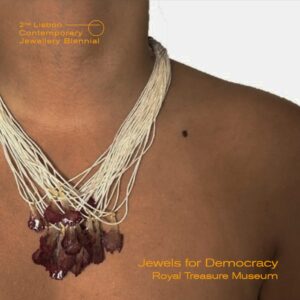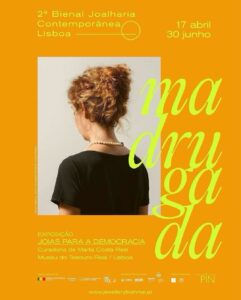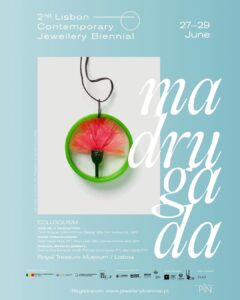Episode 219
What you’ll learn in this episode:
- What to expect at the second Lisbon Contemporary Jewelry Biennial and tips for attending.
- How Portugal’s 48-year authoritarian regime and the Carnation Revolution continue to influence Portuguese artists and jewelers today.
- Why jewelry is so closely linked to power and politics.
- How artists can use masterclasses and workshops to refocus their work.
- How Marta is working to promote Portugal’s art jewelry scene.
About Marta Costa Reis
Marta Costa Reis started studying jewelry in 2004, as a hobby, in parallel with other professional activities. She dedicated herself fully to this work in 2014. Costa Reis completed the jewelry course at Ar.Co – Centro de Arte e Comunicacção Visual, in Lisbon, and the Advanced Visual Arts Course at the same school, in addition to workshops with renowned teachers including Iris Eichenberg, Ruudt Peters, Lisa Walker, and Eija Mustonen, among others. In addition to being a jewelry artist, Costa Reis teaches jewelry history at Ar.Co, writes about jewelry, and curates exhibitions. She also serves as artistic director of the Lisbon Contemporary Jewelry Biennial and as a board member of Art Jewelry Forum.
Additional Resources:
Photos:
Necklace by Barbara Macedo

Jewels for democracy poster

Women during the revolution (marked as author unknown)

Tiara by Teresa Milheiro photo by Luis Martins and Pedro Tropa, Exhibition: Tiara – 40 anos de Joalharia no Ar.Co” 2019

The colloquium poster

Brooch by Cristina Nuno

Transcript:
How does jewelry symbolize power, and where do jewelry and politics intersect? That’s the central question that Marta Costa Reis and her fellow curators, artists and speakers will explore at this year’s Lisbon Contemporary Jewelry Biennial. Marta joined the Jewelry Journey Podcast to talk about why this year’s theme is so timely; how Portugal’s turbulent political history influences jewelry today; and how to plan your trip to make the most of the biennial. Read the episode transcript here.
Welcome to the Jewelry Journey, exploring the hidden world of art around you. Because every piece of art has a story, and jewelry is no exception.
Sharon: Hello, everyone. Welcome to the Jewelry Journey podcast. This is the first part of a two-part episode. Please make sure you subscribe so you can hear part two as soon as it’s released later this week. Today, we’re going to be talking about the Lisbon Contemporary Jewelry Biennial. I am talking with Marta Costa Reis, who is going to tell us all about it.
I met Marta about eight to 5 years ago at the first biennial in Lisbon, Portugal. One of the goals was to gather together examples and information about the history of modern Portugal and the jewelry that’s associated with it. When we think of Portuguese jewelry, we don’t automatically think of art jewelry. But it has a history of more than several decades about the work that’s been going on and art jewelry in general. The second Lisbon Contemporary Jewelry Biennial is coming up this summer in Lisbon. The last one was held in Lisbon, too.
Marta Costa Rice is going to be telling us about this biennial and what to expect this summer in Lisbon. There will be a lot going on in many venues. There is the exhibition at MUDE, which is a very well-known Portuguese design museum. There’s an international symposium with people coming from all over the world to discuss the theme of the exhibition, which I’ll let Marta tell you about. A lot is taking place at many of the galleries. One of the key exhibits is taking place at the Royal Treasure Museum. But I don’t want to steal Marta’s spotlight. Today, she’ll tell us all about the second Contemporary Jewelry Biennial in Portugal. Marta, welcome to the program.
Marta: Thank you so much. Thank you for having me and for this very nice introduction. So, where should I start? I don’t even know. There’s so much to tell. I’m currently organizing the second Lisbon Contemporary Jewelry Biennial. I do it as a new chairwoman of PIN, which is a Portuguese contemporary jewelry association.
Sharon: PIN, P-I-N?
Marta: PIN, yes. PIN has existed now for 20 years. It will be 20 years this September. It was created to organize quite a big event. At the time, Cristina Filipe was one of the founders and was the chairwoman for a very long time. Of course, you know her by the Susan Beach Grant. She received the first Susan Beech Grant for Mid-Career Artists, and that allowed us to publish a book which came from Cristina’s Ph.D. about Portuguese jewelry, contemporary jewelry in Portugal. That time, when the book was published, that’s when she had traveled to Portugal and we met. We had this challenge for ourselves, saying that if we managed to do a good program to present interesting shows, good visits, we could be able to do a biennial. That’s its inspiration, this trip, how all this came to happen.
Of course, the timing for the first biennial—we called it the AJF trip. It was like year zero, the pilot episode. The first biennial happened in the middle of the pandemic, so we were never sure that we really would be able to make it happen because there was still a lot of restrictions. But luckily it happened in September 2021, when people were able to travel a little bit. Then we managed to have a huge number of artists and collectors and interesting people. The theme was about the pandemic. It was jewelry of protection and connecting contemporary objects, contemporary jewelry of protection in the 21st century with very old relics and sacred objects that were shown together in an exhibition in a museum here in Lisbon. Of course, we did call it the biennial to force ourselves to do the second one.
Sharon: I wanted to ask, what does biennial mean, literally?
Marta: It’s supposed to be every two years. That that’s what it means. It’s supposed to happen every two years. Of course, it’s a little bit more than two years now. It’s two years and a half between the first one and the second one. But because we have this idea to always have as a theme for the biennial something that is happening in the world at the moment. The first one was the pandemic. Now in Portugal 2024, we will have this very important event, which is the 50th anniversary of our revolution when we became a democratic country.
I don’t know if people are aware that we had an authoritarian regime for 48 years, and it happened in 1974. It was a very smooth revolution. Let’s just say that, because it happened without almost any gun being shot. Of course, it took a little while. The Democratic constitution was approved a bit later, but that is the fundamental moment when we became a democratic country or started to become a democratic country. It happened 50 years ago now, so it’s really a whole new generation, a whole new world, and we want to celebrate that.
Jewelry, of course, has a lot to do with power or representations of power. There is also in contemporary jewelry a lot of political work. Many artists do work that is political or can be read in a political way. We wanted to consider those issues, jewelry of power and political jewelry. That’s basically the idea of how it came about.
Sharon: Why is it called the Carnation Revolution?
Marta: That’s an amazing story, actually. It happened because literally a woman that had some red carnations in her hands started to put carnations, the flowers, in the guns of the soldiers. Some of the most famous images of the revolution are soldiers with the flowers in their guns. It represents a lot of things, namely that the guns were not being shot. They were holding flowers. It happened by accident. It’s suggested that this lady, apparently one of the soldiers asked her for a cigarette. She said she didn’t have cigarettes, but she had a flower, and she put the flower in his gun. And then people started to replicate the gesture. Until today, the red carnation–there were also white carnations, but basically the red carnation is still very much a symbol of that movement, that revolution, and it took the name. For us, thinking about that, the gesture she had is also very much a gesture of adornment, the gesture of adorning that gun with the flower. So, we wanted to pick up on that and what it could mean.
Sharon: How is jewelry linked to power?
Marta: You have that example, for instance, in the Royal Treasure Museum that you mentioned, which shows the jewelry of the national treasure, jewels that belonged to the state—well, to the crown, basically. Some of them were private jewelry worn by kings and queens. Some of them are more royal estate jewelry. Basically, it’s that representation of the power that it can show and the time when diamonds and precious stones and even precious metals were not used by everyone. It showed how powerful a person was, how important or how close to the eye of power. It’s the idea of a crown or a tiara, of a whole set of diamonds, but also all the objects that you can put on your body, like the jeweled swords and things like that.
Jewelry indeed has a lot to say about power, how you show yourself as a person of power or representing a situation of power, being a king or queen or someone with a very high responsibility. That connection always existed. This museum is brand new. It will be two years ago in June. This jewelry was not accessible. It was not shown for a very long time. It was only in a temporary exhibition, so it’s an excellent opportunity to see these pieces that are absolutely incredible. Although many were lost and sold, they’re still a very nice collection.
Sharon: So, a biennial can be anything, theoretically. Every 10 years, it could be trucks. It could be jewelry, but it could be a biennial about anything, right?
Marta: We tried to connect it to things that are ongoing in the world at the moment. For 2024, our main motivation with this event was that we knew it would happen in Portugal. There will be a lot of other moments of celebration of democracy, basically. That that’s what the celebration is all about. But if you look at the world at large, it’s also very topical, this issue and the themes. It’s something that people can relate to at the present moment, not just Portuguese. That’s what we thought could be interesting, to see how our jewelers, our artists, are connecting to the world at the present and what they have to say about it through their work, through jewelry.
Sharon: How did you get involved in it?
Marta: I don’t know. It’s probably a personality trait. I like to get involved in things. I like this tendency to be of service to something larger than myself. I became involved first with PIN because in my previous professional life, I used to—I was not a lawyer, but I studied law, so I worked with law. I started to be involved with PIN about some situations that were happening with laws that were changing that affected jewelry. So, I started to cooperate with them on that issue. Then I was very much involved in AJF’s first visit to Lisbon, and then in the organization of the first biennial.
Sharon: AJF means—I want everybody to understand that AJF means Art Jewelry Forum.
Marta: Art Jewelry Forum, yes. So, I was the person helping in Portugal. There were others, but I was one of them. I got very much involved in the first biennial and then Cristina wanted to leave and not do the second one. She was very tired and wanted to move on to something else. I said, “Okay, but we did this biennial. We need to try to do the second one.” That’s what happened. And I said, “Okay, I’ll try to take over and do the second biennial.” That’s what happened. That’s my mission at the moment at this organization, the Portuguese Association for Contemporary Jewelry, to do the second biennial, and from then on let’s see how many more we can do.
Sharon: I noticed that she wasn’t on the list of speakers. Are you giving any kind of prize or a grant like Cristina received 10 years ago to do her book?
Marta: No. The program is two exhibitions in the Royal Treasure Museum. One of the exhibitions will be contemporary jewelers doing work to honor a woman of their choice that had a role in the democratic transition, so a woman that was especially hurt by the dictatorship or was especially involved in the democracy. Many of them are artists because we also had censorship and artists could not be free in their work. Many of the women the jewelers chose to honor are artists. A few of them even had to leave Portugal and move to other countries to be able to do their work. But not only do we have anonymous women, we have some politicians. We had one of the first women prime ministers in Europe, so she will be honored as well. There are a few other women that people felt needed some recognition or wanted to give them their recognition.
In 1974, when the revolution happened, many of the actors were men because it was done by military men, and all the politicians were men. A few women started showing up afterwards. But before the end of our dictatorship, women had no representation at all in the public space. They were mostly shown as accessories. Good woman, good wife, good cook, but that’s all. Only after 1974 did women start to have their own representation as professionals in other things besides being wives. We couldn’t even travel to other countries without the husband’s permission or have bank accounts or things like that. When I was born, that was still the reality in my country. It’s not 200 years ago. It’s very, very close to us. That’s also why it’s important to show those who have not lived through that that an authoritarian regime is a terrible thing. So, we are honoring these women.
We have another show of contemporary tiaras by a contemporary artist that will be shown next to the crown jewels. That will be an interesting contrast. These two shows will open in April. So, from April to the end of June, you can see contemporary jewelry in the Royal Treasure Museum, which will also be a first. It’s a very endearing project, and there have been great, great partners.
Then in May, a show by the contemporary artist Teresa Milheiro will open as well. It’s sort of an anthological show, but not only. She always had political themes in her work, so that’s one of the reasons why she was chosen to do this solo. Then in the last week of June, between 24th and 30th of June, there will be an immensity of shows. The big show at MUDE that is curated by myself, Mònica Gaspar and Patrícia Domingues is an international collective show with artists from many different parts of the world. Not all parts of the world, because in many countries you still don’t have a lot of contemporary jewelry. But we’re doing our best to have it as broad as possible.
There will be what we call parallel events, which are shows organized by artists, collectives and students that are doing shows at the same time in Lisbon. There’s the colloquium with international speakers from many parts of the world. The colloquium will be in English. It will also be accessible online for anyone who wants to stay at home and still be able to accompany that. It will also be about political jewelry and politics and politics of jewelry and power. This will still be the main themes.
There will be a show with schools from different countries, a meeting of the students and then an exhibition. The educational part is very present. I’m sure I’m forgetting a lot of things or there are things I didn’t say yet. There will be what you call a jewelry room with galleries from different countries. Galleries are still, and hopefully will be for a long time, a very important part of the jewelry world, so we want them to be present as well and show their artists and their choices. The last week of June will be absolutely filled with contemporary jewelry in Lisbon. Plus it’s an amazing month. It’s the best month in Lisbon. There are parties on the streets. It’s the best.
Sharon: Do the galleries choose what to show that’s linked to this theme? What is the official theme?
Marta: There is a title, which is Madrugada. That means daybreak. This title is inspired by a very beautiful poem by a Portuguese poet, Sophia de Mello Breyner. It’s very short, but basically it says this is a new dawn after a very long, dark night. It’s a poem about the revolution. She loosely calls it a new dawn. This is the theme.
We asked the galleries to bring work that is connected to theme, to political jewelry, and we also asked them to present a Portuguese artist. Some of them already have Portuguese artists in their midst, in their group of selected artists, and some don’t. What we want is for galleries to have a look at the national, Portuguese artists, and make their choice. That way, our Portuguese artists get more representation or more presence and maybe a little more representation in other countries.
Sharon: You mentioned the educational piece of the shows and symposia. What do you have planned, and what are the topics? Are they in English?
Marta: They are in English. The symposium is in English. I can give you some examples. We will have, for instance, and this could be interesting for you, the artist Cindi Strauss will speak about themes from the book she published recently on American jewelry in the 60s and 70s and the counterculture. She will be there. We will also have a Brazilian researcher called Dionea Rocha Watt, and she will speak about jewelry of power, like the jewelry that Imelda Marcos owns, or the jewelry from the recent scandal with the former Brazilian President Bolsonaro, who sold some jewelry he received, and other representations and connections between jewelry and power.
But we will also have, for instance, Rosa Maria Mota, who will speak about traditional Portuguese jewelry. It was used by popular woman from the countryside that bought as much gold jewelry as possible as a way to preserve their finances and their power. It’s the connection between traditional gold jewelry and women power. Things like that. It’s always around politics and policy and power and jewelry. Hopefully it will be very interesting.
Sharon: We will have photos posted on the website. Please head to TheJewelryJourney.com to check them out.
Thank you again for listening. Please leave us a rating and review so we can help others start their own jewelry journey.

